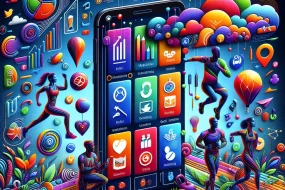
In today's fast-paced world, the role of Artificial Intelligence (AI) in sports analytics is transforming the way athletes, coaches, and teams approach the game. With the ability to process vast amounts of data quickly and accurately, AI is opening new doors to understanding performance metrics, player health, and strategic gameplay. As we delve into this beginner's guide, we'll explore how AI is reshaping sports analytics, providing insights that were once beyond the grasp of traditional methods.
The Rise of AI in Sports: A Historical Perspective
To truly appreciate the impact of AI in sports analytics, it's essential to step back and look at its evolution. Initially, sports analytics was primarily reliant on human observation and simple statistics. Coaches and analysts would pore over game footage, manually recording performance metrics. Fast forward to today, and AI has revolutionized this process. Machine learning algorithms can now analyze thousands of hours of footage in mere minutes, identifying patterns and insights that were previously invisible. This shift didn't happen overnight; it was a gradual integration of technology into sports, driven by the need for more precise and actionable data.
How AI Enhances Performance Metrics
One of the most significant advantages of AI in sports is its ability to enhance performance metrics. Traditional statistics—like points scored or games won—only tell part of the story. AI dives deeper, analyzing player movements, speed, stamina, and even psychological factors that influence performance. For instance, AI-powered wearables can track an athlete's heart rate, oxygen levels, and muscle strain in real-time, providing a comprehensive view of their physical state. These insights allow coaches to tailor training programs to individual needs, optimizing performance and reducing the risk of injury.
AI in Injury Prevention and Recovery
Injuries can be a game-changer, not just for athletes but for entire teams. AI is stepping in as a crucial tool for injury prevention and recovery. By analyzing biomechanical data and historical injury patterns, AI systems can predict an athlete's likelihood of injury and suggest preventative measures. Additionally, AI aids in recovery by monitoring rehabilitation progress and adjusting protocols based on real-time feedback. A practical example is the use of AI-driven apps that provide physiotherapists with data-driven insights, ensuring athletes receive personalized and effective recovery plans.
Strategic Gameplay: AI's Influence on Tactics
Beyond individual performance, AI is revolutionizing how teams strategize. Machine learning models can simulate countless game scenarios, providing coaches with data-driven strategies. By analyzing opponent tendencies and strengths, AI helps teams craft game plans that exploit weaknesses and maximize their own strengths. This is particularly evident in sports like basketball and soccer, where predictive analytics can determine the best player matchups and optimal in-game decisions. The result is a more dynamic and adaptable approach to competition, turning data into a strategic asset.
Common Mistakes in Implementing AI in Sports
While the benefits of AI in sports analytics are clear, there are common pitfalls that teams and organizations should avoid.
1) Over-reliance on technology: It's crucial to balance AI insights with human intuition.
2) Ignoring data quality: Poor data can lead to inaccurate predictions.
3) Lack of expertise: Properly interpreting AI-generated insights requires skilled analysts.
4) Inadequate integration: AI tools must seamlessly fit into existing workflows.
5) Neglecting privacy concerns: Protecting athlete data is paramount.
6) Miscommunication: Ensuring that insights are effectively communicated to coaching staff and players is essential for successful implementation.
The Future of AI in Sports Analytics
Looking ahead, the future of AI in sports analytics is incredibly promising. As technology continues to advance, we can expect even more sophisticated tools that provide deeper insights into performance and strategy. Emerging trends include the use of AI in fan engagement, where personalized experiences are crafted based on fan preferences and behaviors. Additionally, virtual reality (VR) and augmented reality (AR) are being integrated with AI to create immersive training environments. The possibilities are endless, and as AI technology becomes more accessible, its impact on sports will only continue to grow.





























